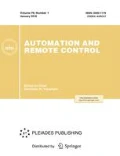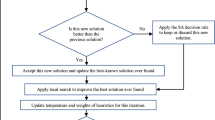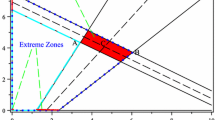Abstract
The network programming method is applied to the discrete problem of minimizing the costs of a project with a given duration. Two basic algorithms for solving this problem in the cases of independent and sequential jobs are described. More complex cases of project scheduling on networks (tree network and aggregated network) are treated by the sequential application of the basic algorithms. For the case of a build-up assembly network, a new method based on the following idea is proposed: an appropriate set of jobs is determined and their durations are fixated so that the resulting network becomes either a tree or an aggregated network. All possible alternatives for fixating the durations of jobs from such a set are considered and, for each alternative, the problem is completely solved. The best alternative among all possible ones is selected. The case of project scheduling on an arbitrary network is also studied.
Similar content being viewed by others
References
Burkov, V.N., Landa, B.D., Lovetskii, S.E., et al., Setevye modeli i zadachi upravleniya (Network Models and Control Problems), Moscow: Sovetskoe Radio, 1967.
Barkalov, S.A., Burkova, I.V., Voropaev, V.I., et al., Matematicheskie osnovy upravleniya proektami (Mathematical Foundations of Project Management), Burkov, V.N., Ed., Moscow: Vysshaya Shkola, 2005.
Andres, C. and Hatami, S., Evolutionary Heuristics and an Algorithm for the Two-Stage Assembly Scheduling Problem to Minimize Makespan with Setup Times, Int. J. Product. Res., 2011, no. 44, pp. 4713–4735.
Allaoui, H. and Artiba, A., Johnson’s Algorithm: A Key to Solve Optimally or Approximately Flow Shop Scheduling Problems with Unavailability Periods, Int. J. Product. Econom., 2009, no. 121, pp. 81–87.
Chenkong, V. and Haimes, Y.Y., The Three Stage Assembly Permutation Flowshop Scheduling Problem, Proc. 5th Int. Conf. on Industrial Engineering and Industrial Management, Cartagena, September 7–9, 2011.
Demeulemeester, E.L. and Herroelen, W., Project Scheduling: A Research Handbook, Boston: Kluwer, 1976.
Garey, M.R., The Complexity of Flowshop and Jobshop Scheduling, Math. Oper. Res., 1976, no. 1(2), pp. 117–129.
Sun, Y., Zhang, C.Y., Gao, L., and Wang, X.J., Multy-objective Optimization Algorithms for Flow Shop Scheduling Problem: a Review and Prospects, Int. J. Adv. Manuf. Technol., 2011, no. 55, pp. 723–739.
Burkova, I.V., A Method of Network Programming in Problems of Nonlinear Optimization, Autom. Remote Control, 2009, vol. 70, no. 10, pp. 1606–1613.
Funding
This work was supported in part by the Russian Foundation for Basic Research, project no. 18-07-01258, and the Russian Science Foundation, project no. 16-19-10609.
Author information
Authors and Affiliations
Corresponding authors
Additional information
This paper was recommended for publication by A.A. Lazarev, a member of the Editorial Board
Russian Text © The Author(s), 2020, published in Avtomatika i Telemekhanika, 2020, No. 6, pp. 17–28.
Rights and permissions
About this article
Cite this article
Burkov, V.N., Burkova, I.V. & Zaskanov, V.G. The Network Programming Method in Project Scheduling Problems. Autom Remote Control 81, 978–987 (2020). https://doi.org/10.1134/S000511792006003X
Received:
Revised:
Accepted:
Published:
Issue Date:
DOI: https://doi.org/10.1134/S000511792006003X




